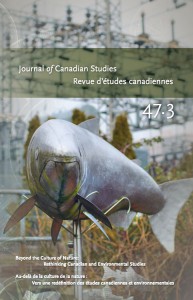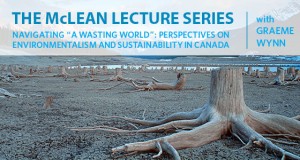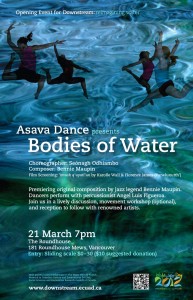In 2012, UBC hosted the Beyond the Culture of Nature conference, sponsored by UBC and NiCHE, the Network in Canadian History and Environment/Nouvelle initiative canadienne en histoire de l’environnement. A special issue of the The Journal of Canadian Studies emerged from this event, which has just been released. The cover art is by UBC PhD student, Jonathan Luedee. Can you guess the location?
Author Archives: mevenden
Colpitts on the Bow River flood, 2013
For an interesting reflective essay on the Bow River floods by University of Calgary historian, George Colpitts, see the recent NiCHE Otter blog.
The Flood Returns on the Bow River
This blog entry was simultaneously posted on the NiCHE Otter blog and the McGill-Queen’s University Press blog and was subsequently carried by The Calgary Herald.
Floods upend the world we know, our habits and our homes. Things are taken away, foundations shift and the power goes out. Lives are lost. Many southern Albertans know about this in a visceral way that I do not. As the water begins to recede on the Bow River this week, however, many people understandably search for meaning. One way to do that is to think about flooding in historical perspective.
Although the 2013 flood will go down as the largest flood in living memory with the widest social impacts, the Bow has risen throughout its history. Float a canoe east of Calgary and you pass high cut banks, dotted with holes for nesting birds, which reveal the outlines of past surges of water and sediment that carved the valley over centuries.
For much of its human history, the Bow figured as an obstruction for the people of the plains, a place to be crossed. The high waters made this difficult and the best fords became central locations along indigenous trails, places for meeting, rendez-vous and crossing. Calgary was established around one of these fords. Treaty Seven was signed at Blackfoot Crossing, another significant ford further downstream, now at the centre of the Siksika reserve.
As people built ranches, settlements and cities along the Bow, they began to live with the risks of flooding. One of the largest floods ever recorded occurred in June 1897, when the Bow flooded after several days of intense rainfall. In the fledgling city of Calgary, bridges were torn out and buildings flooded. Some floated away. Sixty families had to relocate to higher ground. Downstream, ranchers with homesteads on the river had to get out quickly. When the river flooded again the following year, rancher Lachlin McKinnon recorded in his diary, “The spring of 1898 arrived and with it another stab in the back by the Bow River.”
Other floods followed and with time, engineers and government surveyors established gauges and complex instrumentation to measure river flow, assess its seasonal rhythms and forecast the likely flood threat. Significant floods continued to occur in the early twentieth century, but none matched the big event of 1897. Still, early Calgarians had plenty of experience with the Bow’s capacity to burst its banks. After mid-century, however, big summer floods didn’t happen as often. Some assumed that the river had been tamed. Perhaps the hydro dams upriver had shaved off the flood threat? Perhaps settlement itself had succeeded in changing river flow? Hydrologists who built models of stream flow came to a different conclusion. They determined that historical floods were associated with heavy rainfall in the foothills in the early summer, which saturated the ground, followed by intense bursts of high precipitation. Those conditions might return one day, they warned, though for most of the late twentieth century they didn’t.
Calgarians worried much more about winter floods in the middle decades of the twentieth century. A series of events from the late 1930s to the late 1940s witnessed ice jams in the dead of winter, often around bridges, followed by massive surges of slushy water into low-lying sections of the city. Many people blamed the power company and its dams upstream for the problem, though government officials found this difficult to credit. Winter floods also had a long history. What had changed was the built environment along the river which placed houses and businesses in the line of danger where formerly pastures had stood. Nevertheless, after a Royal Commission on the flood problem in 1952, a dam was built at the western edges of the city at Bearspaw to reduce the water flow through the city during the winter months. Like a vast ice trap, the dam lowered the volume of ice through the urban sections of the river and lowered the threat of ice jams and the accompanying floods. Dikes were also built and obstructions like the Eau Claire weir were removed. Winter floods became rare.
In the late 1960s, the City of Calgary decided to revisit the flood threat and hired the Montreal Engineering Company to analyze the risk and make recommendations to meet it. Against prevailing assumptions, the consultants noted that the conditions which gave rise to earlier floods remained. As a result the city expanded its purchase of riverbank lands, dredged the main channel and built up the banks. When government workers cleared trees around St George’s Island in 1973, however, local citizen groups reacted to the blunt aesthetic consequences of flood control work. In response to the uproar the province and city established a Bow River Study Committee to recommend a future course on river management. Many community groups spoke in favour of accepting a measure of flood risk with a view to preserving the natural beauty of the river and its valley bottom. After public meetings and consultants reports, a policy emerged to guide future management, emphasizing park development along the river as well as pathway construction.
As in so many cities of the western world, a river which had once been conceived as a hard-working river, a source of drive, a log transport system and power generator, had come to be understood as a recreational amenity. It still supplied water for power and water for drinking. It still washed away wastes and sewage, but it was nevertheless reconceived as a site of enjoyment and beauty. Where once industrial parks and timber mills had been located, new shopping areas, office towers and condominiums emerged. The urban river lay at the centre of it all as a parkland and recreational space. The threat of the century flood was not forgotten entirely, but nor was it at the forefront of thinking about urban planning.
Recent events bring us full circle to the flood of 1897 but in a radically changed geography of human settlement. Moving forward, the imagination of the river and the human decisions about how to relate to its changing course will be fundamentally altered. Calgary will change. And no doubt the river will be changed as well.
See photos of historical Bow floods here: http://mqup.tumblr.com/post/53929525483/top-picture-flooding-in-calgary-1902-glenbow
The material for this blog entry draws from Christopher Armstrong, Matthew Evenden and H.V. Nelles, The River Returns: An Environmental History of the Bow (Montreal and Kingston: McGill-Queen’s University Press, 2009). See also Stéphane Castonguay and Matthew Evenden, eds. Urban Rivers: Remaking Rivers, Cities and Space in Europe and North America (Pittsburgh: University of Pittsburgh Press, 2012).
McLean Lecture Series 2013
Please join us for this year’s McLean lecture series in Canadian Studies by McLean Chair and Professor of Geography, Graeme Wynn.
“Navigating a ‘Wasting World’: Perspectives on Environmentalism and Sustainability in Canada”
When: March 7, 14 and 21 @ 7pm
Where: Aquatic Ecosystems Research Laboratory, 2202 Main Mall, Lecture Hall,
Map: http://www.maps.ubc.ca/PROD/index_detail.php?locat1=316
A reception will follow the final lecture on March 21.
We look forward to seeing you there!
– Matthew Evenden, Chair of the International Canadian Studies Centre @ UBC http://www.canadianstudies.ubc.ca/
____________________________________________________________________________________________________________________________________
NAVIGATING “A WASTING WORLD”:
PERSPECTIVES ON ENVIRONMENTALISM AND SUSTAINABILITY IN CANADA
LECTURE 1: March 7
TAKING BEARINGS:
THE IMPERFECT ARC OF CANADIAN ENVIRONMENTALISM
LECTURE 2: March 14
UNDER PILOTAGE:
STORIES WE TELL OF FRONTIERS, HOMELANDS, AND WILD PLACES
LECTURE 3: March 21
BY DEAD RECKONING:
FIXING A COURSE FOR THE FUTURE
The three lectures in this series respond to contemporary anxieties, in Canada and elsewhere, about the despoliation of the earth. This is an old concern, given a new twist and a new urgency in the new millennium. Reflecting a conviction that the past, and the humanities, have something worthwhile to contribute to thinking about these matters, these lectures follow a traditional narrative pattern: exposition; rising action; resolution. In sketching, albeit broadly, the history of environmentalism in Canada since the 1960s, lecture one identifies elements of a distinctive Canadian story, allows us to realize that we are neither alone nor helpless in the face of environmental anxieties, and lays out information that underpins the unfolding argument of the series. Lecture two emerges from its predecessor and introduces complications, by focusing on some of the most important stories Canadians have told in recent times about themselves and the environment, about the past and the future of the country, and about nature and nation. Lecture three draws upon the preceding discussions to reflect upon some of the challenges ahead. Rather than resolving them, it brings past and present into conversation in an effort to find a north star, or at least a few ideas, that might help us steer toward a future less bleak than that we are daily forced to contemplate by actions that hasten our progress toward and rhetoric that fears our arrival in a “wasted world.”
Urban Rivers
A belated announcement that Urban Rivers, a volume that I co-edited with Stéphane Castonguay has appeared with the University of Pittsburgh Press in their Urban Environments Series, edited by Joel Tarr and Martin Melosi.
Here is the Table of Contents:
Introduction 1
Stéphane Castonguay and Matthew Evenden
Part I. Industrialization and Riverine Transformations
Chapter 1.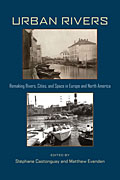
Brussels and Its Rivers, 1770–1880: Reshaping an Urban Landscape 17
Chloé Deligne
Chapter 2.
The River Lea in West Ham: A River’s Role in Shaping Industrialization
on the Eastern Edge of Nineteenth-Century London 34
Jim Clifford
Chapter 3.
An Urban Industrial River:
The Multiple Uses of the Akerselva River, 1850–1900 57
Eyvind Bagle
Chapter 4.
The Rivière des Prairies: More than Montreal’s Backyard? 75
Michèle Dagenais
Part II . Urbanization and the Fu nctions of Rivers
Chapter 5.
The Seine and Parisian Metabolism: Growth of Capital Dependencies in the
Nineteenth and Twentieth Centuries 95
Sabine Barles
Chapter 6.
The Channelization of the Danube and Urban Spatial Development in
Vienna in the Nineteenth and Early Twentieth Centuries 113
Gertrud Haidvogl
Chapter 7.
Rivers and Risk in the City: The Urban Floodplain as
a Contested Space 130
Uwe Lübken
Chapter 8.
The St. Lawrence and Montreal’s Spatial Development in
the Seventeenth through the Twentieth Century 145
Jean-Claude Robert
Chapter 9.
Urbanization, Industrialization, and the Firth of Forth 160
T. C. Smout
Part III . Territorialities of Water Management
Chapter 10.
Diverting Rivers for Paris, 1760–1820: Needs, Quality, Resistance 183
Frédéric Graber
Chapter 11.
Fluid Geographies: Urbanizing River Basins 201
Craig E. Colten
Chapter 12.
To Harmonize Human Activity with the Laws of Nature: Applying the
Watershed Concept in Manitoba, Canada 219
Sh annon Stunden Bower
Conclusion 237
Stéphane Castonguay and Matthew Evenden
Journal of Canadian Studies: Call for Papers
(Le texte français suit)
Call for Papers: Beyond the Culture of Nature: Rethinking Canadian and Environ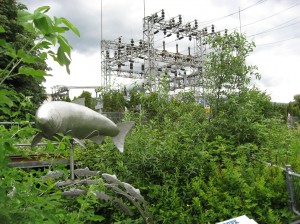 mental Studies
mental Studies
Theme Issue of the Journal of Canadian Studies
Guest Editor: Matthew Evenden
Canadian and Environmental Studies are two fields in transformation. Initiated in part as emancipatory projects in the 1970s, seeking to define subjects and articulate their meanings, the two fields have diverged and been complicated by shifting ideas about nation and nationalism on the one hand, and the environment and sustainability on the other. Wilderness once stood as a central shared concern of the two fields, but constructivist critiques have highlighted its associations with race, gender, settler societies and social power, and the discourse of sustainability has transcended wilderness as a cultural and linguistic artifact, reliant on a binary vision of nature and culture. This special issue asks what has replaced the culture of nature that once provided common ground for Canadian and Environmental Studies? How do area and interdisciplinary studies intersect, and with what benefits and problems? Does a shared agenda remain? This special issue will consider the evolving relationship between Canadian and Environmental Studies scholarship and imagine their intertwined futures.
Possible paper topics include:
The place of nature in Canadian Studies
The place of Canada in Environmental Studies
What’s left of wilderness and the culture of nature?
Understanding Canada, regions and places in a world of global flows and environmental processes
Academics and graduate students nearing completion of a PhD are invited to submit 250-word abstracts for consideration. The deadline for abstracts is 1 September 2012. Papers selected for submission should be made available by 1 December 2012. All papers will undergo a formal peer review process through the Journal of Canadian Studies. Completed abstracts or questions should be directed to the guest editor, Matthew Evenden, at matthew.evenden@ubc.ca
–
Appel de communications
Au-delà de la culture de la nature : Repenser les études canadiennes et environnementales.
Numéro thématique de la Revue d’études canadiennes
Rédacteur invité : Matthew Evenden
Les études canadiennes et les études environnementales sont deux champs en transformation. Entrepris en partie en tant que projets émancipatoires au cours des années 1970, cherchant à définir des sujets et à élaborer leurs significations, ces deux champs d’études ont divergé et se sont complexifiés en même temps que les notions de nation et de nationalisme, ainsi que celles d’environnement et de durabilité, se recomposaient. Autrefois une préoccupation commune de ces deux champs, la nature sauvage (wilderness) est dorénavant associée par les critiques constructivistes à la race, au genre, aux sociétés coloniales et au pouvoir social. Quant au discours sur la durabilité, il a transcendé la nature sauvage en tant qu’artefact culturel et linguistique, tributaire d’une vision binaire de la nature et de la culture. Le présent numéro spécial s’interroge sur ce qui a remplacé la culture de la nature en tant que point commun des études canadiennes et environnementales. Comment est-ce que les études régionales (area studies) et les études interdisciplinaires s’entrecoupent, avec quels bénéfices et quels problèmes? Existe-t-il encore des points de convergence? Ce numéro spécial cherche à rassembler les chercheurs en études canadiennes et environnementales pour discuter et débattre de la relation entre les deux champs d’études et imaginer un avenir commun.
Thèmes de recherche possibles :
– La place de la nature dans les études canadiennes
– La place du Canada dans les études environnementales
– Que reste-il de la nature sauvage et de la culture de la nature?
– Comprendre le Canada, les régions et les lieux dans un monde de circulations globales et de processus environnementaux.
Les universitaires et les étudiants de troisième cycle qui obtiendront bientôt leur doctorat sont invités à soumettre des résumés de 250 mots pour évaluation. La date limite de soumission des résumés est le 1er septembre 2012. Les manuscrits qui seront retenus doivent être remis au plus tard le 1er décembre 2012. Ils feront tous l’objet d’une évaluation formelle par les pairs organisée par la Revue d’études canadiennes. Vous pouvez faire parvenir vos résumés terminés ou vos questions au rédacteur invité, Matthew Evenden, à matthew.evenden@ubc.ca.
Downstream: re-imagining water
On the Isar
This post was published simultaneously on the NiCHE Otter blog.
The River Isar drains north from Austria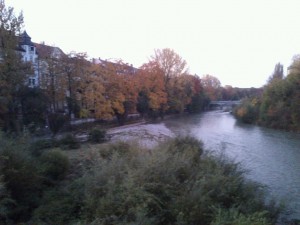 , cuts east through Bavaria and bisects Munich before entering the Danube near Straubing. Viewed from a bridge near the Deutsches Museum on a cold October morning, the post-Oktoberfest fall colours are in view, as well as the modest flow of a redesigned river. Over the twentieth century the Isar, like so many European urban rivers, was plumbed and canalized, made to divert sewage and turn hydro-electric turbines. In the last twenty years a portion of this hard-working flow has been returned from a linear canal to the original river bed studded with new gravels and seemingly natural islands. In Munich’s famous Englischer garden the river tumbles through a naturalistic landscape and cascades in a precise arc over a manicured falls. East of the city, the natural river tumbles past another kind of nature, the Isar nuclear plants near Landshut. Along its length, the Isar reminds us of the many designs on rivers, and of the many rivers made by design.
, cuts east through Bavaria and bisects Munich before entering the Danube near Straubing. Viewed from a bridge near the Deutsches Museum on a cold October morning, the post-Oktoberfest fall colours are in view, as well as the modest flow of a redesigned river. Over the twentieth century the Isar, like so many European urban rivers, was plumbed and canalized, made to divert sewage and turn hydro-electric turbines. In the last twenty years a portion of this hard-working flow has been returned from a linear canal to the original river bed studded with new gravels and seemingly natural islands. In Munich’s famous Englischer garden the river tumbles through a naturalistic landscape and cascades in a precise arc over a manicured falls. East of the city, the natural river tumbles past another kind of nature, the Isar nuclear plants near Landshut. Along its length, the Isar reminds us of the many designs on rivers, and of the many rivers made by design.
Recently I walked along the Isar in the early jet-lagged mornings while attending a conference on energy continuities and transitions, an event sponsored by the Peter Wall Institute at UBC, the Technical University of Munich, the Deutsches Museum and the Rachel Carson Centre, and organized by Richard Unger. The key question animating the workshop was how have societies reoriented around new energy carriers over time? What made European societies adopt coal, or hydro and abandon peat and wood? And why did patterns and processes of adoption vary over time and space? Given pressing contemporary concerns about how to foster a post-fossil fuel future, the problem of transitions and how they have occurred is of more than historical interest. Although none of the papers offered prescriptive assessments based on historical research, participants did collectively point to the significance of fuel prices, institutional and policy contexts, crises, transportation geography, regulation and consumer preferences as factors shaping transitions and continuities in energy regimes. A summary of the presentations will be published in the Perspectives journal of the Rachel Carson Center.
Having recently been immersed in a project with Stéphane Castonguay on urban rivers and currently conducting research on urban water history in Vancouver, I was struck by some of the commonalities between energy history and urban environmental history. At the heart of both fields is a core interest in large systems that interact over distance and combine a complex assemblage of human, technological and environmental actors. The literature on urbanization shares some broad parallels with the literature on energy transition; both search for drivers, elements of institutional lock-in and path dependence. The differences I identified could hardly be isolated to the two fields but nevertheless seemed significant: urban environmental history seems more connected to place-based inquiry, energy history to model building and quantitative analysis of production and consumption trends at the national scale. Urban environmental historians seek to relate political and social change to the environmental context of urbanization and vice versa, whereas energy historians are less explicitly environmental in their concerns or treat environmental outcomes in a more abstract, less place-specific sense. Some of my observations were no doubt conditioned by the range of participants– a mixture of economic and environmental historians, historians of technology, museum professionals as well as engineers and scientists.
The comparison nevertheless strikes me as evidence of the balkanization that has occurred in environmental history in the last decade. New subfields, water and energy history among them, with a range of networks, commitments and intellectual linkages outside of the field of environmental history, have recast our foundations and vantage points. Probably a good thing? A sign of maturation in the field and the expanding realm of inquiry? Or is the centre of environmental history too weak to hold the centripetal intellectual forces at play? Is the problem, as Sverker Sörlin and Paul Warde put it a few years ago, that environmental history lacks a coherent problem at its core, beyond a general interest in human-environmental relationships?[1] Food for thought as I rambled along a re-invented river.
[1] Warde, Paul and Sverker Sörlin, (2007) “The Problem of the Problem of Environmental History: A Re-reading of the Field and its Purpose.” Environmental History, 12 (1). pp. 107-130.
The Assiniboine River Flood
Shannon Stunden Bower has provided a helpful statement on the historical context of the Assiniboine River flood on the NiCHE website. For those of you who don’t know Shannon’s work, she has written on the historical geography of water in Manitoba. She authored an interesting piece on the watershed idea in Manitoba in Environmental History in 2007. Even more relevant to the current situation is her essay in the Journal of Historical Geography published in 2010, entitled “Natural and unnatural complexities: flood control along Manitoba’s Assiniboine River”.
Her new book, to be released in June with UBC Press, is called, Wet Prairie: People, Land and Water in Agricultural Manitoba.
Fountains and public memory
Over the past term, I taught a senior undergraduate seminar on the historical geography of water in Vancouver. We read widely, carried out field trips and visited several archives. The students exceeded my expectations with a series of interesting papers grounded in original research. For example, Adrian Martynkiw analyzed the development and disappearance of a public drinking fountain in the heart of Gastown, which shed light on the role of water in the early city and of the changing function and politics of space. He will be leading a tour of the site as part of the ThinkCity series on May 8. Check it out!
http://tctoursgassyjackpublicdrinkingfountain.eventbrite.com/

